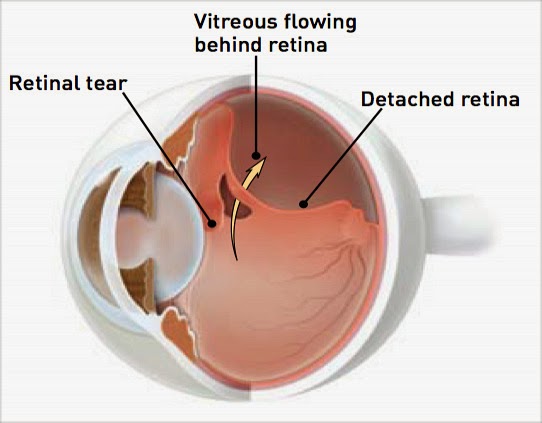

This situation it is still urgent, but surgery may be delayed a little longer. If the detachment has progressed so that the fovea is detached too, it is known as a macula-off retinal detachment. If this is achieved successfully then central vision is very likely to remain normal or thereabouts. An operation will be required, but not necessarily immediately a number of other factors will help decide on the timing of the operation, but it would ideally be done before the fovea is detached. Whilst this is good news, it is generally only a matter of time before the central vision is affected, so urgent attention from a specialist is required. in its correct position, the retinal detachment is known as a macula-on retinal detachment. When the fovea (centre of the macula) is still attached to the RPE, i.e. In some people this can happen very quickly over a matter of hours or even overnight. The build-up of fluid under the retina, stripping the retina off the RPE, causes the growing shadow. This can come form any direction and then, if left untreated, may well move across the centre of vision and have a devastating effect. The next thing that many patients notice is either a dark shadow at the edge of their vision that slowly grows and gets closer to the centre of vision. This is the type of retinal detachment common in young short-sighted people and often is not associated with symptoms of flashes or floaters. Retinal detachments can also occur due to a slow movement of fluid from within the vitreous into the space under the retina through round holes present in areas of peripheral retinal degeneration. These are usually due to a posterior vitreous detachment and progress quite rapidly. Retinal detachments almost always begin at the periphery of the retina, where the patient may not notice any visual problems other than flashes and floaters. The retina is then floppy inside the eye and does not work properly because the photoreceptors (light-sensitive cells) are stripped away from the retinal pigment epithelium (RPE) and underlying choroid, on which they rely for oxygen and nourishment. Fluid from the inside of the eye then passes through the tear and strips the retina off the inside of the eye, a little like freshly pasted wallpaper can sometimes peel off the wall. Most retinal detachments begin when a posterior vitreous detachment causes a retinal tear.

To request a consultation about retinal detachment repair at University Retina, call the office today or schedule an appointment online."analyticsString": "ajax_search-" Either way, it’s essential to address a detached retina as soon as possible. In most cases, your physician can reattach the retina in one procedure, though some people need multiple appointments to ensure success.

What results can I expect with retinal detachment repair? Vitrectomy: a procedure that removes part of the eye’s vitreous fluid Scleral buckle: a flexible band is placed around the eye to drain excess fluid and help the retina return to a normal position Pneumatic retinopexy: a technique that uses a gas bubble to press the retina back into place Your physician might recommend:Ĭryotherapy: for small retina tears a freezing technique that prevents further damage to the retina There are several ways to achieve this, and the type of procedure you need depends on your situation. It’s vital to reattach the retina as soon as possible to protect your vision. Flashes, for example, may be more recognizable at night. Symptoms may come and go, and they may be more noticeable in certain conditions. Most people don’t experience any pain with retinal detachment, but they are likely to notice other disturbing symptoms, including:įloaters: small, dark spots or specks that drift in and out of your field of visionįlashes: sudden bright spots of light usually seen out of the corners of the eyeīlurry vision: loss of normal vision or reduced peripheral vision a sense that a shadow or curtain is covering your vision field What are the symptoms of retinal detachment? In the most severe cases, retinal detachment can result in blindness. As a result, it stops receiving oxygen, which can cause a wide range of symptoms that interfere with normal vision. Retinal detachment occurs when the retina, a thin layer of tissue at the back of the eye, becomes detached from the eye structure.


 0 kommentar(er)
0 kommentar(er)
